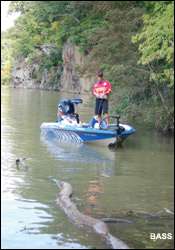
For John Crews, size matters when the topic is crankbaits. In fact, the Salem, Va., pro has developed what he calls a small crankbait game plan designed specifically for prespawn and fall bass. It's a strategy that involves very specific sizes and types of these lures.
"It's a total size deal," says Crews. "By small, I mean anything 2 1/2 inches long or less from the eyelet to the rear treble, and the body shape can be either short and fat or short and skinny.
"Because these baits are so subtle, they're ideal for finicky prespawn bass. And in the fall, small cranks are perfect for bass from the time the water starts to cool and the bass move to the backs of creeks until the time they travel back to the main lake or anyplace the water is deeper than 6 to 8 feet."
SPECS FOR THE IDEAL SHORT CRANK
Crews is a big fan of small crankbaits like the SPRO Fat Crank 20. With a weight of 3/8 ounce and length of 2 1/4 inches, this round crank runs about 2 feet deep. The 28-year-old Virginian became so confident in the ability of shallow cranks that he convinced SPRO to design what he feels is the ideal bait of this type. (Note: This yet unnamed bait should be available by spring 2007.) The specifications are as follows:
Castability. Most baitcasters don't cast small cranks well, he says, because the weights lie non-aerodynamically in the belly. Crews' cranks feature a weight transfer system where the weight goes to the tail when the lure is cast and settles in the belly when the bait is retrieved.
Action. Crews wanted a small crank that fulfills a new niche, that is one that produces a "medium-hard wobble/thump" when it is retrieved, somewhere between the tight wobble/thump of a Rapala Shad Rap and the wide wobble/thump of a Balsa Bagley B.
Bill. The pro didn't desire another bait with a lexan bill but one with what he describes as a "computer chip bill" — a rigid and thin square shape with a slightly rounded edge.
Hooks. Too many small crankbaits, he says, offer No. 6 trebles that are so little they lose fish or No. 4s so large that they result in too many hang-ups. Crews' choice: No. 5 round bend Gamakatsu hooks that don't impede action and are razor sharp.
Colors. This small crankbait technique works best in stained water, so the Old Dominion sportsman requested that SPRO manufacture models in mostly chartreuse and craw patterns with a few shad imitators.
THE RIGHT KIND OF TRIBUTARY BANK
Crews follows basically the same game plan for working tributaries during the prespawn and fall.
"I'll start by running from front to middle to back, often stopping to look for water color that offers 6 inches to a foot of visibility," he explains. "Ideally, I don't want the water to have more than a foot of visibility. A little muddier is okay, but a little clearer is not unless there's a lot of cloud cover and wind.
"Once I find the right clarity, I follow the creek channel until I come to a bend, and it doesn't matter whether it's an inside or outside one. A good spot to crank is where the channel meets the bank, but a great place to fish is the transition area where the bank and channel start to separate."
Come autumn, continues Crews, one other type of location will hold bass. At this time, fish tend to locate on flats more, especially ones with baitfish and that offer stumps, logs or other cover.
Another difference then is that anglers will often encounter scattered lone bass, instead of coming across concentrations as is often the case in the spring. The Virginian also lists two "wild card" situations for both prespawn and fall:
• Docks — particularly ones existing in the transition zone. "Docks can make even a flat bank good and hold fish throughout the day," explains Crews. "Be sure to work docks repeatedly on both sides."
• Laydowns — especially ones adjacent to a bank. This is another situation that offers the potential for multiple bass.
RETRIEVE OPTIONS
Crews notes that 90 percent or so of the time he will retrieve a small crank at a fast, steady pace. But before he leaves a proven area, he will also throw in a few erratic stop and start efforts and then conclude by reeling a crank down to the strike zone and twitching it like a jerkbait.
DEVELOP THE FEEL
The Virginia pro emphasizes that one advantage of using high quality rods, reels and line is that anglers will eventually be able to develop a feel for their tiny cranks.
"You'll be able to detect, say, whether a crankbait is running across a hard, mud or rocky bottom," he says. "Better still, you'll learn when the lure scratches against random pieces of rock or wood on that bottom.
"When you encounter that random piece of cover, you should really pound it with repeated casts from different angles. You might have to make a half dozen casts before you get a strike. That's the type of spot most fishermen will miss."
Crews doesn't miss much when he fishes small crankbaits
from working them to designing them.
GEAR CHOICES
REEL. Abu Garcia Revo STX-HS with a 7.1:1 retrieve ratio. Crews proclaims that anglers will need a reel with a ratio of at least 6:1. A smooth drag is also very important so that the small trebles do not tear out of a bass' mouth.
ROD. 6 1/2-foot Fenwick Techna AVC 66MF with medium action and fast tip.
LINE. 12-pound-test Berkley Trilene Sensation or 10-pound Berkley Trilene Maxx.




